By Pauline Weston Thomas for Fashion-Era.com
How to Date Old Photographs by the Costume
This new section below is devoted to dating old photographs and pictures by analysing costume, fashions, hats & jewellery worn by the wearers in the photos. Use costume history to date photos. Learn tips and hints and examples to help you to achieve a date within 5 years either way of the photo 's original date. This will make your genealogy research so much more meaningful to you and your family.
Learn by example how to use your own detective skills to examine your photo in detail. See how close you can get to the date which in some cases you may be able to verify with documentation.
- Using Costume History to Date an Old Photograph
- My Reply to Norman Estimating the Date of the Old Photograph
- Look for the Most Fashionable Details
- Hats
- Edwardian Hat Analysis
- The Possible Date of the Photograph
- Norman's Response to my Dating the Photograph Deduction
- Sir Humphrey Davey
- Ship Building Yard in Hebburn
Using Costume History to Date an Old Photograph
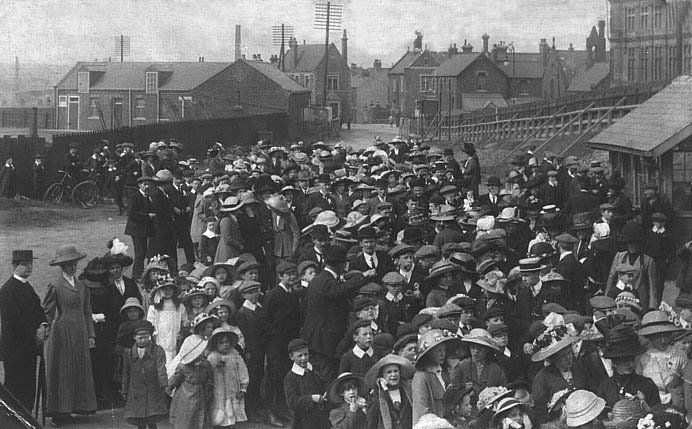
The photograph shown here is an example of a crowd scene at the turn of the 20th century. It's a wonderful picture and I am showing it here to enable you readers to see how to analyse your own picture. My technique of using the costume as the main point of reference may help you to date your own picture to within 5 years.
In this example, I believe that I have dated this photograph within one year. To do this can be something of a tall order because a photograph such as this might take several days of thinking time. Then after I have mulled over it, several hours of actual close study of the detail. This picture of old Hebburn was kindly sent to me by Norman Dunn who has a website of old photographs he has been collecting for many years.
All pictures enlarge on this page and this picture is superb when enlarged.
For an even larger/closer view, click below here on this tiny thumbnail and see the original picture scan.
My Reply to Norman Estimating a Date of the Old Photograph
This is the text I wrote to Norman:-
I've been studying this photograph now for some hours, because it really does interest me in getting the date right. Even at first glance, it is clear that this picture is a superb representation of Edwardian middle class folk, with some working class folk; the key point is that all the people are dressed in the fashions of the day.
The scene suggests they are either waiting for someone special to visit, such as the King or Queen, alternatively, that they are awaiting with serious intent for bad news of some accident, such as a mining or factory disaster. Another possibility is that they are awaiting transport to take them on a trip for the day.
If the year was slightly later I might think they were seeing men off to war. Another point to be aware of is that at least some of the crowd may old fashioned, and behind the times in their dress.
I'd say the photograph was taken in Spring as they all wear coats, but also fashionable Spring-like hats, which could be Easter Bonnets for Mothering Sunday.
Look for the Most Fashionable Details
Clothes, Hair and Hairstyles
When dating a costume picture by dress, I always seek out the most fashionable details, which are generally found in younger women.
These details refer not only to the garments themselves, but also the hairstyle, particularly hair partings and whether the hair fringes or sweeps up. Another source of clues are the hats, examine their width, height and snugness of fit.
Hats

This photograph has no hairstyles to concentrate on, but it does have wonderful hats by the dozen. The fashion hats are the main clue here, as no heads are visible in the adult women. These hats are wide enough to be circa 1908-9, but could be as early as 1902 bearing in mind some of the clothes. Even with magnification I cannot find one single woman without a hat or head covering.
This picture is living proof that the era was still dominated by formality, even the ordinary people obey the rules of etiquette as you can see in the photograph. That formality was swept away by the First World War when rigid rules of dress codes were broken down. And this point helps us to date a photograph as the early part of the twentieth century.
I've circled a copy of the original photograph as the detail is crisper and some circles will be used here to identify certain aspects of costume history details.
The Circled Sections in the Picture of the Old Hebburn Crowd Scene
Several factors amongst the images suggest that we should date the photograph after 1895, up to the later dates of 1912. I don't feel this photograph is later than 1912, even in an unfashionable town.
The boys with bicycles in the left hand side background are wearing Eton style school-uniform jackets, and collars often featured in books circa 1895. The puffed heads on garment sleeves are very subdued so that dates the picture later than 1895.
Edwardian Hat Analysis
Other than where specified, I am in all cases referring to female adult fashionable dress. I can eliminate 1904 as a possible date as there simply is not enough fullness in the sleeves of any of these adult garments, moreover, the children's dress supports this view. I believe it is after 1904 and the factor that suggests this most is the rounded domes of the hats. You can see what I mean by looking at the many instances of hats, as in circles 6, 8 and 12.
These detailed circled sections are beside the explanatory text.
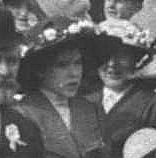

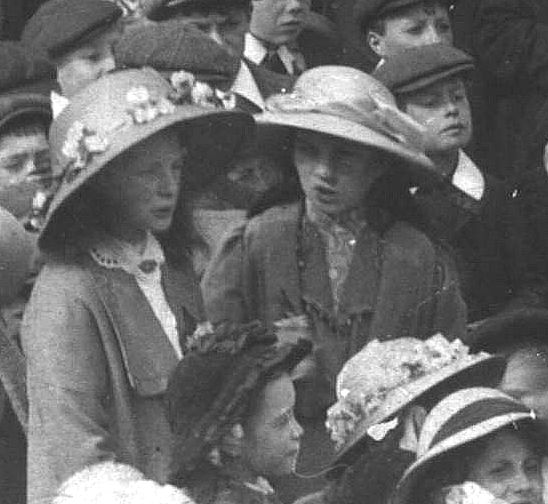
Let's look at the picture starting with circle 1. Elements of the coat could suggest it to be circa 1898. The sleeves with soft fullness at the head and the fitted silhouette suggest late Victorian styling. But the hat is too big for that date. Hats tight and neater, with less width, were dominant in the late 1890s.
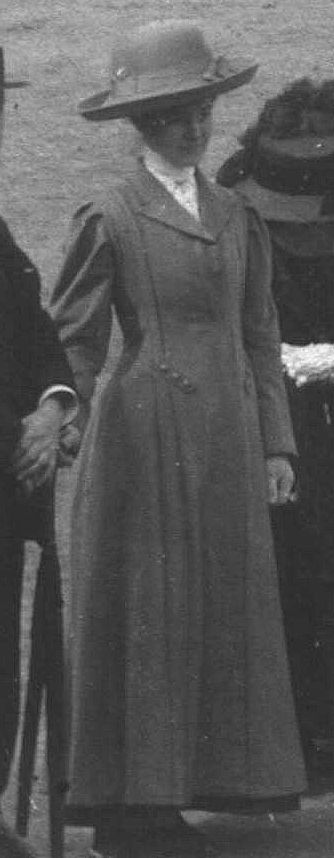
Reference circle 1 left, is probably one of the best sections to use for generally dating the picture.
The picture below for reference 1 enlarges fully. The coat is typically Edwardian, and because a waist is in evidence, I think it is before 1910.
After that date, waistlines were much higher following Directoire styles and under-the-bust empire lines, but of course, when women buy a coat they even now expect 2 or 3 years of wearing from it.
In those days they may have hoped for even longer wear.
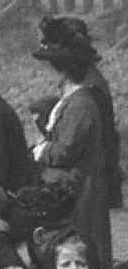
The silhouette back of the coat in circle 9 shown right, is very straight indicating no swing-back sway, which was created by the S-bend style of 1900-1906.
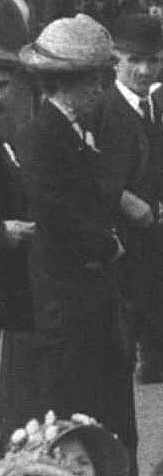
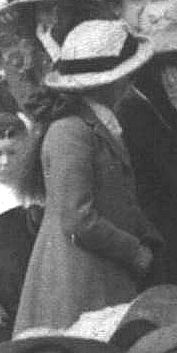
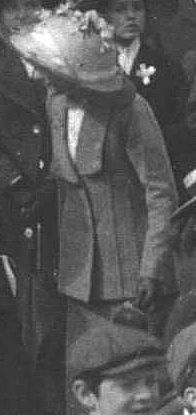

Reference circle 5 above centre shows a typical tailor-made suit circa 1907-8. The necklines and tailoring of refernce circles 1, 3, 4, 6, and 11 could all be as late as 1912.
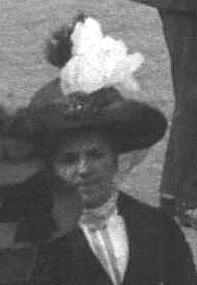
Hats in reference circles 2 and 10 right show veiling which may be mourning veiling or motoring veiling.
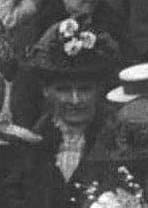
1907-8 saw the start of a new body silhouette called the Empire, or Directoire, where the long columnar outline that tapers to the feet is contrasted with the big Merry Widow picture hat.
The fashion designer Lucile had designed the original widow hat for an operetta in 1907, but it influenced hat fashions for 3 more years. It was always black and encased in filmy chiffon or organdie and festooned in feathers.
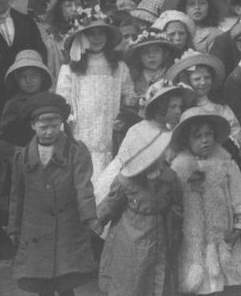
The children wearing straw hats in circle 13 are wearing early forms of straw cloche hats. They are not as close fitting as the later cloches, but they show early signs of the fashion.
The cloche hat was not confined to the 1920s as is often first thought. It was fashionable from 1908 to 1933 was one of the most extreme forms of millinery ever, with an appearance that resembled a helmet.
Cloches existed in many forms including one with a beret like top.
By 1911 hats became much smaller, although large wide picture hats were still worn for dressy functions.
I think that there are too many garments with slightly puffed head sleeves for this to be as late as 1914. By 1914 all fullness in sleeve heads was well gone.
The Possible Date of the Photograph
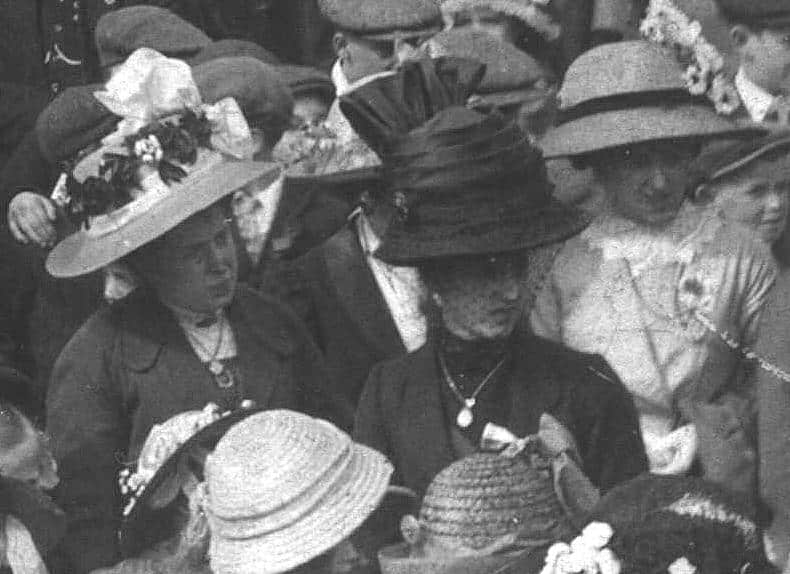
The black hat in circle 14 is probably the most up-to-date hat in the picture. There are dozens of hats there, but that hat speaks volumes in terms of style and only she wears a hat like that.
We will date the photograph by that hat and I think it is 1910. The hat she wears is an early form of the toque.
Likewise, the lady in picture reference 14 wearing a pale dress/jacket next to her is wearing a modern garment with sleeves in the new cut where they dropped slightly down the arm. So I will date the picture at 1910.The black hat in circle 14 is probably the most up-to-date hat in the picture. There are dozens of hats there, but that hat speaks volumes in terms of style and only she wears a hat like that. We will date the photograph by that hat and I think it is 1910. The hat she wears is an early form of the toque.
I suppose bearing in mind your comment at the time of the war there is not much between 1910 and 1914, but there are substantial fashion changes between 1912 and 1914 that eliminate those dates, now often known as the Titanic era. This picture leans more toward full late Edwardian styling than Titanic era styling.
I'm inserting some of my hat drawing pictures. You can see how the last picture has elements like the black hat in the street scene and how the others have similar features. The lady in the picture wears a hat which is a combination of all these I've drawn. they will be available with others in my next ebook.
Typical Hat Styles of 1910
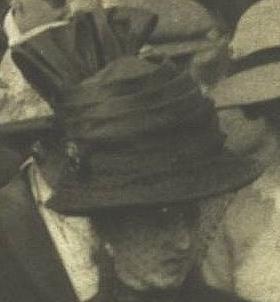
Compare the photo with the drawings.
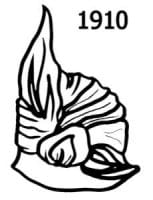
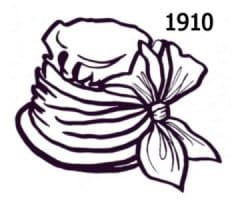
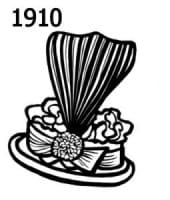
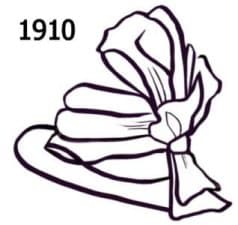
Male Hats
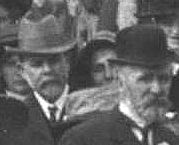
The dress, beards and hats of the men is similar in fashion to that favoured by Edward VII and George V.
It really is a wonderful picture of children in dress. However, the problem with the children's clothing is that it was often handed down.
In the main it's typical Edwardian-era clothing for children. I think they are very smartly dressed for a crowd scene and would really like to know more about the picture.
Norman's Response to My Dating the Photograph Deduction

In response to this analysis, Norman wrote back and told me he thought it a great deduction.
He has since told me that Hebburn is about 5 miles from the North Sea, and stands on the south bank of the river Tyne 6 miles from Newcastle upon Tyne, making the people there 'Geordies'.
The photo was taken in his hometown of Hebburn and is on card the same thickness of a Postcard. The folk on the Old Hebburn photo above were Parishioners from the 'Argyle St Wesleyan Chapel' in Hebburn. Norman was told it was possibly an outing on Easter Sunday.
He doesn't know anymore than that even though he has tried hard to find out more information. I did notice that one of the women in the photo centre has a selection of small badges on her coat lapels, typical symbols worn by members of church based organizations such as Band of Hope Temperance Society, or the Mother's Union sections.
A closer look at the photograph also reveals that standing at the far left hand side is a man ina clerical collar, possibly the Church Minister. Clerical Figure shown right.
Sir Humphrey Davey
In the late 1700s, Hebburn was just a clutter of miners houses round the three Collieries, 'A'Pit' 'B'Pit and 'C' Pit. Sir Humphrey Davey who invented the miners Safety Lamp went to Hebburn in 1816 and with gas from the 'B' pit he tested his lamp. All three pits were closed by the early 1900's.
Ship Building Yard in Hebburn
A Scottish man called Andrew Leslie set up a Ship building yard in Hebburn in 1853 and the most famous ship was WW2 warship HMS Kelly which was portrayed in the film 'In Which We Serve' . The Kelly's Commander was Lord Louis Mountbatten and every Armistice day he came to Hebburn to take part in the march up to the Kelly grave in our cemetery. (Lots of Kelly men are buried in a mass grave after it was torpedoed in the North sea).
Other Industries in Hebburn
Many Irish and Scottish folk flooded into the town looking for work. Before that there were Tin Miners from Cornwall going there for work. So Hebburn people can trace family trees back to Cornwall, Wales, Ireland or Scotland. Some Welsh teachers went there to work in the Schools, so the Geordies really are a mixture. Hebburn also had Chemical Works, Copper works, Lead Works, Coke Works, Ship repairs with large Dry Docking, Large Electrical Companies, etc.
In the photograph the building on the right with all the windows is still there today. It was called 'The County Hotel' in those days and probably where Mountbatten stayed on his visits. Just behind it is St Aloysius Church. It and the Priests house in front of it were extended after WW1 so are still there, but looking different. No one can remember the properties to the left with fence leading up to it, but an Aluminium manufacturer had that land then (The Bauxite Company).
You can visit Norman's site showing hundreds of old photographs of the region and its people here at www.norman.dunn247.comIf you have old pictures of the Tyneside area and the people please consider donating them to Norman's site. If anyone reading this knows more about the picture analysed here please write to me or Norman
For those interested in more about Hebburn, Norman has suggested they check out the site he uses called www.hebburn.org and suggests then going on the Hebburn Forum to ask questions, answer peoples queries and talk about the past in that area.
One thing I do know is that as I examined this photograph I felt a connection to real people behaving in much the same way we might whilst waiting for an event that happened almost 100 years ago. I felt I would have liked to have known the lady with the most fashionable black hat.
I just know we would have had much to chat about. I am sure she shopped until she dropped too.I wonder if anyone of the people in this old photograph could have envisaged that they each would be studied with such interest so far ahead in time. Wouldn't it be wonderful if one of those small children were alive today and able to tell us about that special day trip they had.
A Crowd scene of old Hebburn with children and women and men of all ages.
The costume in the photograph is analysed in detail with snapshots of the main elements of the picture that lead to a date conclusion.
Here are more photos for photo detectives:
Dating photos from the 1800s: A portrait study of Charlotte Emma Pitman a young lady who lived in Mid Victorian Britain.